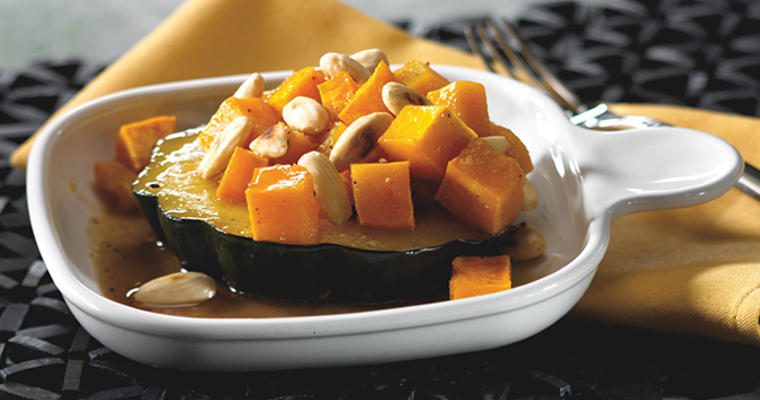As produce continues to nudge protein out of the spotlight, many chefs and operators feel out of step with the veg-centric dining trend. I’ve received feedback from restaurant professionals across the country who say vegetarian dining doesn’t fit with their concept. Many wonder why they should build their menu around vegetarians. The answer is ”They shouldn’t.” And neither should you. Veg-Centric is not a restaurant theme—it is an emerging menu part that in many cases is replacing the category of “sides”. Additionally, it differs from vegetarian in that many of the dishes contain meat or seafood protein elements and thus are not meatless dishes.
This is a seismic shift in the way Americans are eating. It’s not about taking away but rather about adding more: more flavor, more options, more creativity. It’s about keeping the steak and upping the ante with fire-roasted carrots and salsa verde. It’s about paying produce the same respect as the protein. Brussels sprouts, cauliflower, and carrot (peels, stems, and all) happily share space with sweet potatoes, bok choy, and broccolini, by turns anointed with bacon or crispy pork belly, dollops of crème fraiche, bone marrow, rich broth glazes, or sublime chunks of duck confit. By using aggressive cooking methods—e.g., wood-grilling, charring, and roasting—seasonal produce takes on sensational flavor worthy of a star turn on the plate.
While most customers equate vegetables with healthy eating, veg-centric cooking puts flavor first, and it’s this ethos that has paved the way for its success. A great example is the delicata squash stuffed with chorizo and greens at Untitled at the Whitney Museum in New York City. Served on a base of squash purée, its double punch of flavor is amplified by the piquant chorizo and earthy greens.
Spotlight on winter squash
Winter squash is highly economical, ridiculously versatile, and has widespread appeal, so it’s no surprise that we’re seeing it become a star ingredient. Restaurant Santina in New York serves a winter-squash carpaccio: paper-thin ribbons of squash brushed with olive oil and caramelized to order with a handheld torch. The squash is then topped with cumin-scented labneh and pumpkin seeds.
Publican in Chicago covers an avocado salad with thin-shaved squash ribbons tossed in olive oil and vadouvan spice (a French derivative of Indian masala), fresh grapes, and sunflower seeds for an unlikely combination that evokes those delicious days between summer’s end and the first crisp days of fall.
Simpler preparations are no less enticing; slices of tempura-battered Kabocha squash, ready for dunking in a sweet soy dipping sauce, bring street food to a whole new level at the takeaway window of Susan Feniger’s Mud Hen Tavern in Los Angeles.
Veg toast
Fancy toast. It’s really a thing. And why not? For years we’ve happily gobbled up bruschetta—and have loved all the colorful and flavorful combinations that took toast beyond standard at-home breakfast fare—so it’s not a huge stretch to reboot the concept with outside-the-box toppings.
Start with a flavorful spread—either a soft cheese or a rich vegetable purée—on thick-sliced toast. To me, a nice artisan sourdough is perfect: rustic with a crisp crust and toothsome crumb. Timna in New York layers grilled bread with sweetbreads, grilled corn, and lamb belly on a schmear of smoked butternut-squash purée. Zinc Café in Los Angeles tops toast with a rich cauliflower purée, grilled asparagus, and white cheddar. Vegetable jams, like the spicy-tomato version at Chicken and Farm Shop in LA, are perfect topped with a boiled egg.
New-fashioned crudité
The crudité platter is a super retro throwback, but today’s fresh take features a wider array of vegetables. It often includes miniature or heirloom varieties left in their whole state: miniature rainbow carrots, scrubbed but unpeeled; tiny Persian cucumbers; and crisp radishes, whose tops make a convenient handle for dipping.
Because there will, of course, be dip.
Far and away the No. 1 accompaniment is some version of green-goddess dressing. You can cream it up with avocado or buttermilk, strip it down to a vinaigrette, or blend it into sour cream—it’s versatile, delicious, and vibrantly colored. At Chicago’s Boeuf Haus, crudités resemble a bouquet, nestled on a bed of ice in a cocktail glass, resplendent with bell peppers, green beans, daikon radish, and creamy green-goddess dipping sauce. Bonus points for dramatic presentation: fresh greenery (like celery leaves, chives, and carrot or fennel fronds) adds visual depth; cracked ice keeps the veggies crisp and cool.
If you’re just starting to consider adding veg-centric dishes to your menu, I recommend replacing simple side dishes with more complex vegetable small plates. Get inspired by specialty and heirloom varieties, whose fleeting season often means they’re not available on the conventional mass market—this is one of the best reasons to visit your local farmers market. Veg-centric dining is a huge opportunity; let’s make the most of it.




























